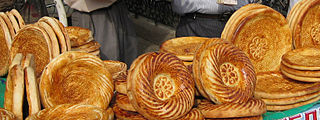 W
WXinjiang cuisine reflects the cooking styles of many ethnic groups of the Xinjiang region and refers particularly to Uyghur cuisine. Signature ingredients include roasted mutton, kebabs, roasted fish and rice. Because of the Muslim population, the food is predominantly halal.
 W
WBeshbarmak is a dish from Central Asian cuisine. It is also known as naryn in Xinjiang, Uzbekistan, Kyrgyzstan and Kazakhstan, as turama or dograma in Karakalpakstan, North Caucasus and Turkmenistan, as kullama in Bashkortostan and Tatarstan. It is a national dish of Kyrgyzstan and Kazakhstan.
 W
WChorba or shorba, refers to several kinds of soup or stew found in national cuisines across the Balkans, Central Europe, Eastern Europe, Central Asia, Middle East and the Indian subcontinent. It is often prepared with added ingredients but served alone as a broth or with bread.
 W
WDapanji or chong texse toxu qorumisi, is a type of chicken stew. It is a popular dish that originated in Xinjiang, China.
 W
WLaghman is dish of meat, vegetables and pulled noodles from Central Asian cuisine. The noodle is known as latiaozi in China.
 W
WManti is a type of dumpling popular in most Turkic cuisines, as well as in the cuisines of the South Caucasus and Balkans, Central Asia, Afghanistan, Iran, Pakistan, Bukharian Jews and Chinese Muslims. Manti are also consumed throughout Russia and other post-Soviet countries, where the dish spread from the Central Asian republics. The dumplings typically consist of a spiced meat mixture, usually lamb or ground beef, in a thin dough wrapper and either boiled or steamed. Size and shape vary significantly depending on the geographical location. Manti resemble the Chinese jiaozi and baozi, Korean mandu, Mongolian buuz and the Tibetan momo and the dish's name is cognate with the Korean mandu, Chinese mantou and Japanese manjū, although the modern Chinese and Japanese counterparts refer to different dishes.
 W
WSamsa is a savoury pastry in Central Asian cuisines. It represents a bun stuffed with meat and sometimes with vegetables.
 W
WTandyr nan, tandir non (Uzbek) or tonur nan, also called lepyoshka, is a type of Central Asian naan.
 W
WTsampa or Tsamba is a Tibetan and Himalayan staple foodstuff, particularly prominent in the central part of the region. It is glutinous meal made from roasted flour, usually barley flour and sometimes also wheat flour. It is usually mixed with the salty Tibetan butter tea. It is also eaten in Turkestan and Mongolia, where it is known as zamba.